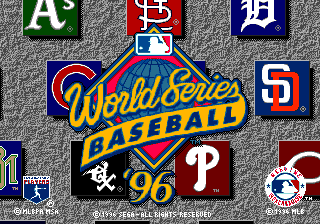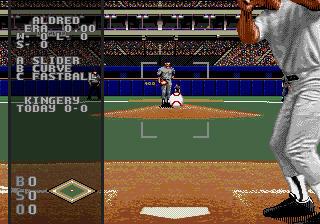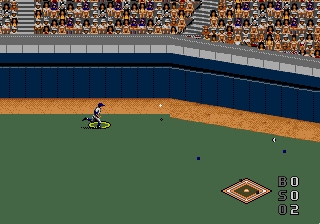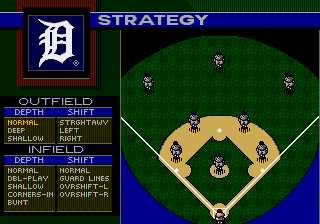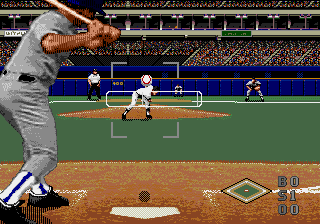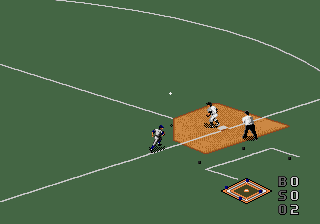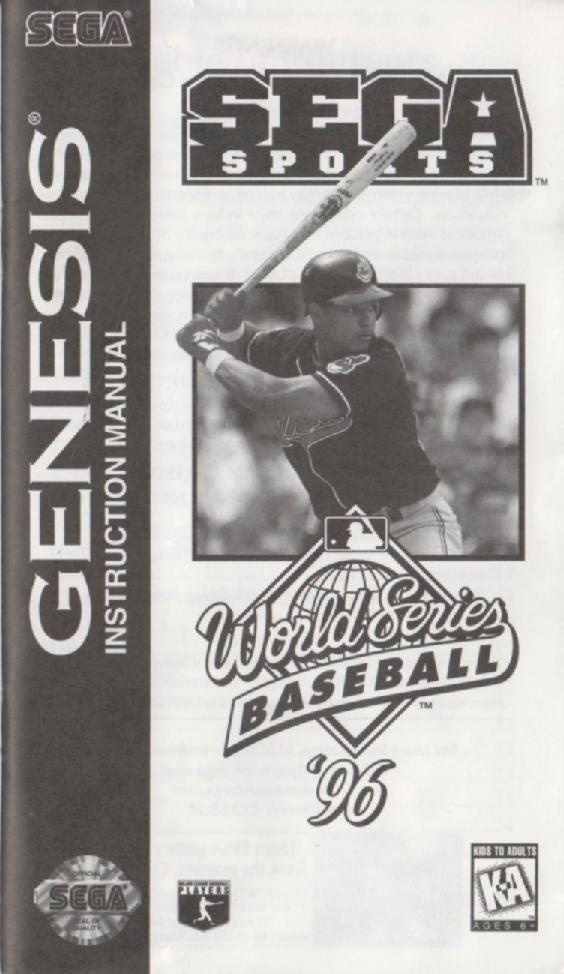Difference between revisions of "World Series Baseball '96 (Mega Drive)"
From Sega Retro
(literally just copy/pasted the WSB 95 article) |
|||
| Line 20: | Line 20: | ||
}} | }} | ||
}} | }} | ||
| − | + | '''''World Series Baseball '96''''' is a baseball game in [[Sega]]'s ''[[:Category:World Series Baseball (franchise)|World Series Baseball]]'' franchise. The game is a roster update to ''[[World Series Baseball '95]]''. It was released exclusively for the [[Sega Mega Drive]] in North America. A [[PC]] version was planned{{magref|gamepro|99|102}}, but cancelled. | |
| + | |||
| + | ==Gameplay== | ||
| + | The game plays identically to ''World Series Baseball '95'' for the [[Sega Mega Drive]]. It features all 28 teams and 700 players from the [[wikipedia:1996 Major League Baseball season|1996 MLB season]], along with all 28 ballparks. The game additionally features several special teams: the American League Stars, National League Stars, and MLB Stars (consisting of the best players from each league or from both leagues) and the American League Legends, National League Legends, and MLB Legends (all-star teams including historical players such as Babe Ruth). | ||
| + | |||
| + | *'''Exhibition:''' A single game against a human or computer player. The player can also watch two computer-controlled teams play. Assigning control to a human is done before the game by moving the player to a team with {{left}} or {{right}}, then the game is started with {{Start}}. | ||
| + | *'''League:''' Plays a season of games that culminate in the World Series. The player can choose the number of games (13, 26, 52, 104, or a full 162 games) and the number of divisions (4 or 6). The game has the ability to draft and trade players. There is a mid-season All-Star Game whose members are chosen based on the player's season. The game uses a [[battery backup]] to save the player's progress. | ||
| + | *'''Playoffs:''' A truncated season with only the play-offs. Progress in this mode is also saved using the battery backup. | ||
| + | *'''Batting Practice:''' The player practices batting. There are no outs in this mode. The player can select a left- or right-handed pitcher, a left- or right-handed batter, the type of pitch, and the venue. | ||
| + | *'''Home Run Derby:''' Players have 10 attempts to hit as many home runs as possible. A missed attempt is a hit that is not a home run; there are no strike-outs. This mode can be played by up to 8 players taking turns. | ||
| + | *'''Classic Home Run Derby:''' This mode is a home run competition that retains outs and innings. Like a standard baseball game, the player pitches during one half of the inning and hits in the other half, but there is no fielding or baserunning. The player with the most home runs after nine innings is the winner. It can be played by one or two players. | ||
| + | |||
| + | The scoreboard is shown at the beginning of the game and after each play (and can be shown by calling a time-out with {{Start}}). The scoreboard has a menu that allows players to set the batting line-up, change the defensive position of each player, and choose the starting and relief pitchers. Starting pitchers have more stamina than relief pitchers, but players can have up to two relievers warm up to their maximum stamina in the bullpen. The scoreboard also provides options including selecting the difficulty for pitching and batting separately (Rookie, Veteran, or All-Star), setting the length of the game (3, 6, or 9 innings) before the first pitch, and toggling auto-fielding. | ||
| + | |||
| + | {{InfoTable|imagewidths=320| | ||
| + | {{InfoRow | ||
| + | | title=Defense | ||
| + | | screenshot=World Series Baseball 96 MD, Defense, Pitching.png | ||
| + | | screenshot2=World Series Baseball 96 MD, Defense, Fielding.png | ||
| + | | screenshot3=World Series Baseball 96 MD, Defense, Strategy.png | ||
| + | | tabs=yes | ||
| + | | desc=On each pitch, the player positions the pitch using the D-Pad and chooses the type of pitch to throw with {{A}}, {{B}}, or {{C}}. Each pitcher has a repertoire of three pitches from eight different possible pitches (fastball, split-finger, slider, sinker, curveball, change-up, screwball, or knuckleball). The strike zone appears in brackets in the center of the screen. | ||
| + | |||
| + | After choosing the type of pitch and its position, the player chooses the speed of the throw: {{A}} for slow, {{B}} for medium, or {{C}} for fast. The pitcher can also throw to base with the D-Pad ({{right}} for first, {{up}} for second, or {{left}} for third) to pick-off runners trying to steal a base or throw a pitchout (a pitch deliberately thrown outside of the strike zone to make it easier to catch) with {{down}} to prevent baserunners from stealing a base or to thwart a squeeze play. | ||
| + | |||
| + | When fielding, the D-Pad controls the player closest to the ball. If auto-fielding is enabled, the fielders automatically move toward any ball hit near them. The position of the ball is highlighted with a yellow circle when it is near the ground. The player can have the nearest fielder dive for the ball by pressing {{B}} while holding a direction or jump by pressing {{B}} while the fielder is standing still. Once the ball is in possession, it can be thrown to base by pressing {{C}} while holding a direction corresponding to the base ({{right}} for first, {{up}} for second, {{left}} for third, or {{down}} for home). If no direction is held, the ball is thrown to the cut-off man or to the pitcher. | ||
| + | |||
| + | The player can open the scoreboard with {{Start}} to check the score, warm up relievers, substitute pitchers or fielders, play a replay, or change the options. There is also the ability to change the defensive strategy by changing the depth and shift of outfielders and infielders. | ||
| + | }} | ||
| + | {{InfoRow | ||
| + | | title=Offense | ||
| + | | screenshot=World Series Baseball 96 MD, Offense, Hitting.png | ||
| + | | screenshot2=World Series Baseball 96 MD, Offense, Running.png | ||
| + | | tabs=yes | ||
| + | | desc=Before each pitch, the player chooses the type of swing: {{A}} for contact, {{B}} for normal, or {{C}} for power. Contact is a light hit to put the ball into play; power is a hard hit to try to get a run. The strike zone appears in brackets in the center of the screen. Hitting comes down to aim and timing. The player moves a batting bar at the ball with the D-Pad and swings with {{C}} or bunts with {{A}}. The batting bar is shaped like a bat and indicates where the bat will make contact with the ball. It has two vertical lines that indicate the "sweet spots" on the bat. On Rookie difficulty, the player does not need to aim the hit and only needs to swing. On Veteran, the batting bar is always the same size, while on All-Star, the size of the bar and the positions of the vertical bars vary depending on the batter. | ||
| + | |||
| + | After selecting the type of swing, runners can be instructed to lead-off by holding {{B}} while tapping a direction on the D-Pad corresponding to the base that the runner is currently on (({{right}} for first, {{up}} for second, or {{left}} for third, or {{down}} for all baserunners). Runners can attempt to steal a base by holding {{B}} while holding a direction on the D-Pad. | ||
| + | |||
| + | When running, the player can slide to base with {{C}}. The player can control the runners on base by holding a direction on the D-Pad ({{right}} for first, {{up}} for second, {{left}} for third, or {{down}} for all baserunners) with {{B}} to run to the next base or {{A}} to return to base. | ||
| + | |||
| + | The player can open the scoreboard with {{Start}} to check the score, make substitutions, play a replay, or change the options. | ||
| + | }} | ||
| + | }} | ||
| + | |||
| + | ===Teams=== | ||
| + | {| class="prettytable" | ||
| + | ! League !! Division !! Team | ||
| + | |- | ||
| + | | rowspan="14" | American | ||
| + | | rowspan="4" | Western | ||
| + | | California Angels | ||
| + | |- | ||
| + | | Oakland Athletics | ||
| + | |- | ||
| + | | Seattle Mariners | ||
| + | |- | ||
| + | | Texas Rangers | ||
| + | |- | ||
| + | | rowspan="5" | Central | ||
| + | | Chicago White Sox | ||
| + | |- | ||
| + | | Cleveland Indians | ||
| + | |- | ||
| + | | Kansas City Royals | ||
| + | |- | ||
| + | | Milwaukee Brewers | ||
| + | |- | ||
| + | | Minnesota Twins | ||
| + | |- | ||
| + | | rowspan="5" | Eastern | ||
| + | | Baltimore Orioles | ||
| + | |- | ||
| + | | Boston Red Sox | ||
| + | |- | ||
| + | | Detroit Tigers | ||
| + | |- | ||
| + | | New York Yankees | ||
| + | |- | ||
| + | | Toronto Blue Jays | ||
| + | |- | ||
| + | | rowspan="14" | National | ||
| + | | rowspan="4" | Western | ||
| + | | Colorado Rockies | ||
| + | |- | ||
| + | | Los Angeles Dodgers | ||
| + | |- | ||
| + | | San Diego Padres | ||
| + | |- | ||
| + | | San Francisco Giants | ||
| + | |- | ||
| + | | rowspan="5" | Central | ||
| + | | Chicago Cubs | ||
| + | |- | ||
| + | | Cincinnati Reds | ||
| + | |- | ||
| + | | Houston Astros | ||
| + | |- | ||
| + | | Pittsburgh Pirates | ||
| + | |- | ||
| + | | St. Louis Cardinals | ||
| + | |- | ||
| + | | rowspan="5" | Eastern | ||
| + | | Atlanta Braves | ||
| + | |- | ||
| + | | Florida Marlins | ||
| + | |- | ||
| + | | Montreal Expos | ||
| + | |- | ||
| + | | New York Mets | ||
| + | |- | ||
| + | | Philadelphia Phillies | ||
| + | |} | ||
==Production credits== | ==Production credits== | ||
Revision as of 16:09, 16 January 2023
| World Series Baseball '96 | ||||||||||
|---|---|---|---|---|---|---|---|---|---|---|
| System(s): Sega Mega Drive | ||||||||||
| Publisher: Sega | ||||||||||
| Developer: BlueSky Software | ||||||||||
| Licensor: Major League Baseball Properties, Major League Baseball Players Association | ||||||||||
| Sound driver: GEMS | ||||||||||
| Peripherals supported: Six Button Control Pad | ||||||||||
| Genre: Sports | ||||||||||
| Number of players: 1-2 | ||||||||||
|
World Series Baseball '96 is a baseball game in Sega's World Series Baseball franchise. The game is a roster update to World Series Baseball '95. It was released exclusively for the Sega Mega Drive in North America. A PC version was planned[4], but cancelled.
Contents
Gameplay
The game plays identically to World Series Baseball '95 for the Sega Mega Drive. It features all 28 teams and 700 players from the 1996 MLB season, along with all 28 ballparks. The game additionally features several special teams: the American League Stars, National League Stars, and MLB Stars (consisting of the best players from each league or from both leagues) and the American League Legends, National League Legends, and MLB Legends (all-star teams including historical players such as Babe Ruth).
- Exhibition: A single game against a human or computer player. The player can also watch two computer-controlled teams play. Assigning control to a human is done before the game by moving the player to a team with
 or
or  , then the game is started with START .
, then the game is started with START . - League: Plays a season of games that culminate in the World Series. The player can choose the number of games (13, 26, 52, 104, or a full 162 games) and the number of divisions (4 or 6). The game has the ability to draft and trade players. There is a mid-season All-Star Game whose members are chosen based on the player's season. The game uses a battery backup to save the player's progress.
- Playoffs: A truncated season with only the play-offs. Progress in this mode is also saved using the battery backup.
- Batting Practice: The player practices batting. There are no outs in this mode. The player can select a left- or right-handed pitcher, a left- or right-handed batter, the type of pitch, and the venue.
- Home Run Derby: Players have 10 attempts to hit as many home runs as possible. A missed attempt is a hit that is not a home run; there are no strike-outs. This mode can be played by up to 8 players taking turns.
- Classic Home Run Derby: This mode is a home run competition that retains outs and innings. Like a standard baseball game, the player pitches during one half of the inning and hits in the other half, but there is no fielding or baserunning. The player with the most home runs after nine innings is the winner. It can be played by one or two players.
The scoreboard is shown at the beginning of the game and after each play (and can be shown by calling a time-out with START ). The scoreboard has a menu that allows players to set the batting line-up, change the defensive position of each player, and choose the starting and relief pitchers. Starting pitchers have more stamina than relief pitchers, but players can have up to two relievers warm up to their maximum stamina in the bullpen. The scoreboard also provides options including selecting the difficulty for pitching and batting separately (Rookie, Veteran, or All-Star), setting the length of the game (3, 6, or 9 innings) before the first pitch, and toggling auto-fielding.
Teams
| League | Division | Team |
|---|---|---|
| American | Western | California Angels |
| Oakland Athletics | ||
| Seattle Mariners | ||
| Texas Rangers | ||
| Central | Chicago White Sox | |
| Cleveland Indians | ||
| Kansas City Royals | ||
| Milwaukee Brewers | ||
| Minnesota Twins | ||
| Eastern | Baltimore Orioles | |
| Boston Red Sox | ||
| Detroit Tigers | ||
| New York Yankees | ||
| Toronto Blue Jays | ||
| National | Western | Colorado Rockies |
| Los Angeles Dodgers | ||
| San Diego Padres | ||
| San Francisco Giants | ||
| Central | Chicago Cubs | |
| Cincinnati Reds | ||
| Houston Astros | ||
| Pittsburgh Pirates | ||
| St. Louis Cardinals | ||
| Eastern | Atlanta Braves | |
| Florida Marlins | ||
| Montreal Expos | ||
| New York Mets | ||
| Philadelphia Phillies |
Production credits
- Developed by: BlueSky Software
- Game Design: Chuck Osieja, Jay Panek, Dana Christianson
- Producer: Chris Smith
- Assistant Producer: David Perkinson
- Product Manager: Brad Hogan
- Lead Artist: Scott Seidel
- Artists: Rick Randolph, John Seidel, Joe Shoopack, Drew Krevi, George Simmons, Ray Ferro, Phil Gordon, Brian McMurdo, Chris Kreidel, Amber Long, Dok Whitson, Geoff Knobel
- Lead Programmer: David Dentt
- Programmers: Bill James, Larry Claque, Kevin Baca, Mike Nana, Dave Kunkler
- Sound, Speech, and Music: Sam Powell
- Voice Talent: Steve Mollenhauer, Tim Stavlor, Scott Seidel, Chuck Osieja, Jay Panek, John Holland
- Manual: T.S. Flanagan
- Test Lead: Dave Paniagua
- Assistant Lead Tests: Lorne Asuncion, Danny Dunn, Matt Prescott
- Testers: Rey Alferez, Don Carmichael, Marc Dawson, Mike Dobbins, Scott Farrar, Sam Ford, John Fosnaugh, Chris Garrett, Rob Hernandez, Roderick Hong, Christina Hurley, Ryan Hurth, Matt Ironside, Jeff Junio, Ian Levin, Chris Lucich, Matt Lucich, Tony Lynch, Conner Morlang, Darren Nagtalon, Raul Orozco, Sean Potter, Tony Ragano, Ben Rubright, Len Sayers, Kathleen Silkworth, Jeff Silveria, Tim Spengler, Brian Thoroman, Ferdinand Villar, Pat Walsh, Jeremy Wheat, Charlie Yang, Peter Young
- Sega Sports Team: Chris Cutliff, Gerald DeYoung, Rosie Freeman, Tracy Johnson, Scott Rohde
- Marketing: John Gillin, Anne Moellering, Christine Nunn
- Special Thanks: John Carlucci, Tom Carrol, Tom Dipace, James Doval, Angela Edwards, Sean Hennessy, Michael Kramer, Mark Lorenzen, Willie Mancero, Matt McDonald, Mike McMahon, Joe Miller, Tom Moon, Mark Paniagua, Steve Payne, Karl Robillard, Helene Sheeler, Matt
Magazine articles
- Main article: World Series Baseball '96 (Mega Drive)/Magazine articles.
Physical scans
| Sega Retro Average | |||||||||||||||||||||||||||||||||||||||
|---|---|---|---|---|---|---|---|---|---|---|---|---|---|---|---|---|---|---|---|---|---|---|---|---|---|---|---|---|---|---|---|---|---|---|---|---|---|---|---|
|
| 74 | |
|---|---|
| Based on 7 reviews | |
Technical information
ROM dump status
| System | Hash | Size | Build Date | Source | Comments | |||||||||
|---|---|---|---|---|---|---|---|---|---|---|---|---|---|---|
| ✔ |
|
3MB | 1996-05-03[12] | Cartridge (US) |
References
- ↑ https://groups.google.com/g/rec.games.video.sega/c/fBWxpxsPS-g/m/JKwXLqcGR2AJ
- ↑ 2.0 2.1 GamePro, "September 1996" (US; 1996-xx-xx), page 88
- ↑ Press release: 1996-05-16: ALL-STAR LINE-UP OF SEGA SPORTS VIDEOGAMES EXPANDS THE PROVEN TOP-SELLING FRANCHISE
- ↑ GamePro, "December 1996" (US; 1996-xx-xx), page 102
- ↑ File:World Series Baseball 96 MD US Manual.pdf, page 22
- ↑ 1700 igr dlya Sega, "" (RU; 2001-xx-xx), page 342
- ↑ Game Players, "Vol. 9 No. 9 September 1996" (US; 1996-08-06), page 84
- ↑ Game Informer, "August 1996" (US; 1996-0x-xx), page 22
- ↑ Next Generation, "September 1996" (US; 1996-08-20), page 162
- ↑ Tricks 16 bit, "Tricks Sega Gold 800 igr" (RU; 1998-03-20), page 298
- ↑ VideoGames, "September 1996" (US; 1996-08-20), page 77
- ↑ File:WSB96 MD BSZone1.png
| World Series Baseball '96 (Mega Drive) | |
|---|---|
|
Main page | Hidden content | Magazine articles | Reception | Region coding | Technical information | |
| Games in the World Series Baseball Series | |
|---|---|
| World Series Baseball (1994) | World Series Baseball '95 (1995) | World Series Baseball '96 (1996) | World Series Baseball 98 (1997) | |
| World Series Baseball (1993) | World Series Baseball '95 (1994) | Nomo's World Series Baseball (1995) | |
| World Series Baseball Starring Deion Sanders (1995) | |
| World Series Baseball (1995) | World Series Baseball II (1996) | World Series Baseball 98 (1997) | |
| World Series Baseball '96 (1996) | |
| World Series 99 (1999) | World Series Baseball (2001) | |
| World Series Baseball 2K1 (2000) | World Series Baseball 2K2 (2001) | |
| World Series Baseball (2002) | World Series Baseball 2K3 (2003) | |
| World Series Baseball related media | |
| Prima's Official Strategy Guide: World Series Baseball 2K1 (2000) | |
- Six Button Control Pad-compatible games
- 1-2 player games
- US Mega Drive games
- All US games
- Mega Drive games
- 1996 Mega Drive games
- All 1996 games
- Mega Drive sports games
- All sports games
- All games
- Old technical information
- World Series Baseball '96 (Mega Drive)
- World Series Baseball (franchise)
- Unreleased Windows PC games
